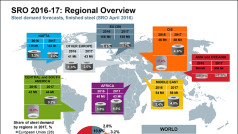After three “painful” years, the steel industry appears to be on a slow path to recovery, with the World Steel Association (WSA) projecting global apparent usage growth of 3.1% this year and 3.3% in 2015, Mr Rubach pointed out. However, he also acknowledged that the scrap industry is continuing to suffer from “severe margin compression” and a “huge overcapacity” which “will remain for a long time”.
Mr Rubach went on to suggest that, partly as a result of the “good co-operation” between BIR and the Turkish Steel Producers Association, there have been some “slight signs” of progress with regard to the threat of restrictions on European steel scrap exports. He quoted Robrecht Himpe of ArcelorMittal Europe, the newly-elected President of European steel association Eurofer, as saying: “Eurofer has no intention to regulate exports of European scrap further as it stands behind its fair trade policy. Taking such a move would create a precedent against fair trade.”
Mr Rubach welcomed this development, as well as invitations for BIR to meet with the European Commission to discuss export control problems and with the WSA “to intensify our co-operation”.
Commenting on scrap-related developments in Latin America’s leading steelmaking markets, Ignacio Sanchez of the Tenaris Group noted that some steel mills in Brazil are pushing for scrap export limits but the government has opted to postpone a decision on this issue. In Mexico, meanwhile, scrap exports are low and falling each year owing to rising domestic requirements.
In his market report for the EU, Turkey, Russia and Ukraine, European Ferrous Recovery & Recycling Federation (EFR) President Tom Bird spoke of “cautiously optimistic” expectations for this year’s third quarter but also of margins remaining under pressure in the EU. “We have a little time to wait before we see trading levels and utilisation up to acceptable levels,” he stated.
A similar theme was adopted by William Schmiedel of Sims Metal Management in the USA in addressing the American, Asian and Pacific Rim markets. “Sales volume and liquidity do not appear to be an issue,” he said, “but the common lament I hear as I travel worldwide concerns margin erosion which is a direct result of overcapacity. This will not change until it is utilised or rationalised.”
Despite forecasting an upsurge in China’s domestic availability of obsolete scrap in just under a decade from now, guest speaker Renate Cakule doubted whether this would trigger large-scale exports from the country. The Senior Steel Market Analyst at Wood Mackenzie in the UK also predicted that Turkey’s imports of steel scrap will climb from just under 20m tonnes last year to 26m tonnes by the year 2025 and that India will remain an important “swing buyer” of scrap on the international market.
Chris Plummer, Managing Director of US-based Metal Strategies Inc., promised delegates “17 facts on the steel industry that may surprise you” in his guest presentation. He contended, for example, that China’s excess steelmaking capacity is lower than that of the EU-27, NAFTA and Japan on a percentage basis and that, historically, “steel mills do best when their raw materials are at their highest pricing”.








